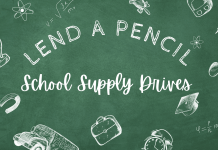When I hear the phrase “back to school”, I think of crowded aisles filled to the brim with shiny new supplies–the endless options of crayons, colored pencils, regular pencils, and pens that will never fit inside those sequin-swathed pencil bags, which is this year’s must have in elementary school, according to a 7 year old. Ah, yes, it’s that time of year!
Except…this is 2020. And in 2020, the conversation surrounding “back to school” is marked by new procedures, policies, and available choices within the context of none other than a pandemic. Parents are in unfamiliar waters navigating with neither map nor compass facing the complicated question of how, and in some cases, whether to send their children to school in the fall. In many areas, schools are presenting a few boats to jump into: Face-to-Face Learning, Distance Learning, or a “hybrid” schedule.
As a family therapist, and former elementary and middle school counselor, I’ve helped many students and parents find their maps and compasses to navigate during times that they’ve felt lost at sea. When approaching the topic of “back to school’ in 2020, I think it’s most helpful to start by breaking down some of the options parents have been given to make an informed choice. Let’s look at Face-to-Face Instruction and Distance Learning a little more closely.
Face-to-Face Instruction (In-Person Attendance)
As parents explore the option of Face-to-Face Instruction, an important thing to keep in mind is that, from drop-off to pick-up, there are going to be new safety routines and guidelines to follow. And, parents, if you think this is overwhelming for you just imagine what it’s like for your kindergartner, so remember to share your calm with your child and not join their chaos.
Start by having a discussion with your children around safety–what it is, what it has looked like in the past, and what it’s going to look like at school now. Depending on their age, you may need to help define safety in terms they’ll understand and compare it to something that is already familiar to them. Stay as up-to-date as possible on your school’s plans for keeping students and teachers safe at school, and incorporate a version of these safety practices into your routines at home. Empower your child to participate in keeping everyone, including themselves, safe by practicing hand washing routines, disinfecting toys or workspaces at home, practice getting in the habit of putting on a mask when leaving the house, and familiarizing them with social distancing habits (i.e. elbow bumps instead of fist bumps, distance hugs/high-fives)–if you have multiple children in a household, you now have an excuse to keep them apart all throughout the day in the name of “practice,” you’re welcome.
Don’t forget to talk to your kids about why these routines are important, always highlighting safety. You can also highlight the adults who are there to help them at school, such as: “Your teacher is there if you need help with your mask” or “What do you think you can do if you’re not sure about where you should stand in line now?”
Kids’ brains LOVE routine because it’s that magical combination of familiarity and predictability. Predictability makes kids feel safe, and when they feel safe their brains are free to devote more energy to soaking up all the knowledge that their teacher has worked so hard to organize for them over the summer. Practicing safety routines ahead of time will help make them second-nature for your child once they are physically on-campus again so they’re able to devote their energy to learning, not worrying.
Distance Learning (Remote Instruction)
For some families, distance learning, sometimes referred to as remote instruction, is the option they believe is going to be the best fit for them. An important consideration for parents choosing this option is how to supplement developmental tasks and social/emotional skills that are naturally built into the school day through things like rules, classwork, and socializing or recess.
Social developmental tasks for parents to focus on for their pre-school age child include: creating new friendships, understanding rules/limits/consequences, and self-regulation and coping. Here are some tips for building these skills away from school:
- Encourage your child to maintain friendships through the supervised use of video-chat technology and ask their teacher what types of opportunities they’ll have to do this throughout the day from home.
- Create rules and limits around your at-home school routine and schedule that mimic the ones they have at school. Do your best to stick to these routines, but model flexibility when necessary (I was always amazed at pre-school teachers’ ability to do this so beautifully!)
- When your child experiences BIG feelings, help them regulate to lay the foundation for self-regulation. For example, let’s say your child suddenly throws their coloring sheet and crayons off the table. Helping them get regulated might sound something like, “I see you’re frustrated because that’s not turning out like you wanted it to. Would you like me to sit with you until you’re ready to try again?” Once they’re ready, you can gently encourage them to pick up the sheet and crayons and talk about different ways of handling frustration the next time they experience it–the goal here is to demonstrate acceptance of all emotions and provide supportive guidance toward making a different choice next time.
Social developmental tasks for parents to focus on for their elementary and middle school-age child include: taking/considering others’ perspectives, social comparison and self-esteem, and focusing attention and planning. Here are some tips for building these skills away from school:
- Having a sibling presents a built-in opportunity to practice taking someone else’s perspective. Frequently asking children to consider someone else’s behavior in the context of what they might’ve been thinking or feeling at the time builds empathy and compassion. For siblings, it can also create a bond around the shared experience of at-home learning.
- It is normal and healthy for kids to compare themselves to others, it can help them learn new skills and fine-tune established ones. Highlighting your child’s strengths and normalizing growth areas can go a long way in mitigating any potentially harmful effects of social comparison. Encourage a growth mindset such as, “You didn’t get the grade you wanted on your math test this time, and you learned what to study to try again and do better next time.”
- Focusing attention and planning are two aspects of executive function. Executive function is a set of skills people develop that aid in memory, self-control, and flexible thinking. For younger children, parents may want to focus more on the self-control piece of focusing attention by helping them practice patience, noticing and naming feelings, and guiding them in choosing how to respond to their feelings. With older children who have more experience with self-control, parents can help them refine their planning skills, flexible thinking, and memory. Allowing older children to develop a process for tracking, organizing, and completing school work is essential…and so is letting them fail occasionally. Allow your child to come up with their own process and plan for schoolwork, while you continue to monitor their progress. When they’ve forgotten an assignment, it’s okay to check in with them and see if there is anything you can do to help support their success in school but taking complete responsibility for the choices they make about their school work may hinder the development of these vital skills. Also, there’s nothing that drives teachers crazier than a parent who does their child’s work for them.
There Is No Perfect Solution
I’ve heard from many parents that none of these options are ideal, and I deeply empathize with the anxiety that comes with having to make a choice like this, in a time like this. I often talk with parents that I work with in therapy about not striving to be a perfect parent but rather a “good enough parent”. In this conversation, I usually cite research that shows that infants will have quality relationships with their caregivers if their needs are met roughly 50 percent of the time or more. 50 percent!! Parents only have to get it right half the time in order to have a positive impact on their child’s development. I think that’s an important thing to keep in mind in this situation, no matter which option you choose. Don’t strive to make the perfect choice because here’s a hard truth: it doesn’t exist. Rather, strive to make the choice that’s going to have the most positive impact possible for your family.
This guest post was submitted by:
Katie Keith – a Licensed Marriage and Family Therapist Associate with the Institute for Couple and Family Enhancement. She provides child and family therapy services to help resolve a variety of challenges that families experience. Prior to the ICFE, Katie worked as an elementary and middle school counselor at St. Peter Prince of Apostles and Blessed Sacrament Catholic schools in San Antonio. She is a new professional member of the Texas Association for Marriage and Family Therapists, professional member of San Antonio Association of Relational Therapists, and is pursuing additional credentialing as a Registered Play Therapist. Katie believes that working with children and their families is a privilege and is honored to be a part of every client’s journey to healthier relational connections.











